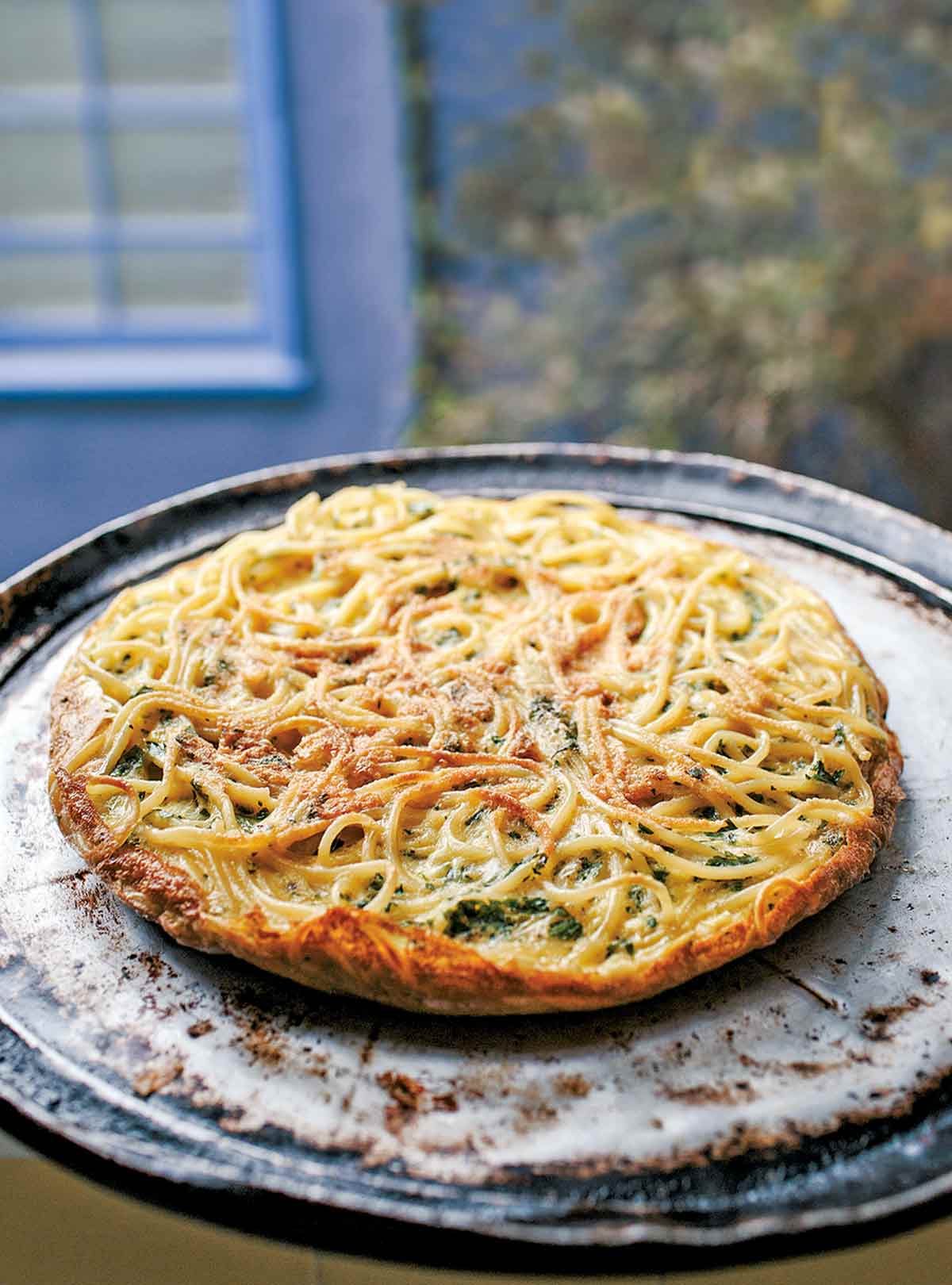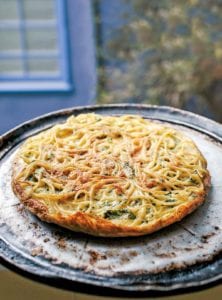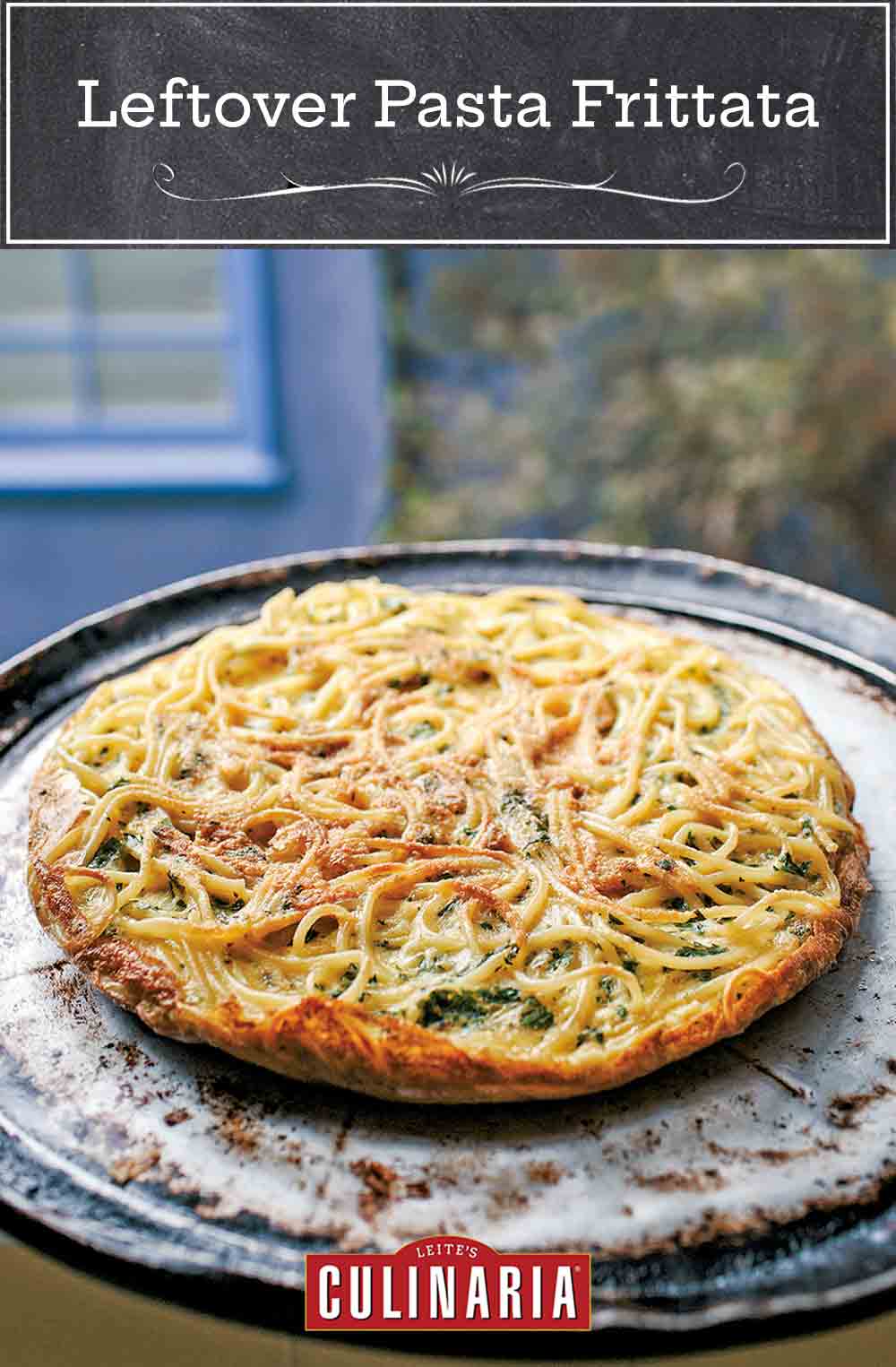
To create a leftover pasta frittata, start by warming last night’s puttanesca, pesto, primavera, or any other sauced pasta in a skillet with a couple of tablespoons of water. Or go with unsauced spaghetti for a crisper effect.
Having the filling hot when it’s mixed with the eggs helps with the flipping step by sort of cooking the frittata from the inside and avoiding over-browning the bottom before the center is set. To avoid unappealingly dry overfluff, I cook frittatas on the stovetop and never in the oven. It’s a little trickier, but it keeps the texture right and the flavor factor high.
Want to Save This?
[Editor’s Note: We know a lot of you are sorta scared of the dreaded frittata flip. And we can understand that. But we’re here to assure you that you can let that fear go. The directions in the leftover pasta frittata recipe below should see you through the moment with ease and perhaps even grace. As one of our recipe testers said, “It is a nervous minute or two when flipping the frittata, but it does become easier with practice, and it makes for a dramatic presentation if you happen to have an audience in the kitchen when you’re preparing it.” And if for some reason, despite your and our best efforts, the flip still flops, so what? Just nudge it back together as best you can, finish cooking it, plop it on some plates, and grab your forks. It may look like a jumble, but it’ll still taste spectacular.]–Cal Peternell
*Can I Use My Cast Iron Skillet For This Recipe?
Yes, Dorothy, you can use a well-seasoned cast-iron skillet in place of nonstick in most instances. Including here. The trick is that it really does need to be pretty slick from use. We’ve made this pasta frittata countless times in our cast-iron skillet, though we have heard from folks who had a tricky time with the frittata releasing. You simply want to make certain the skillet has no rough patches and you may want to use just a smidgen more oil for effortless flipping and nonsticking.

Leftover Pasta Frittata
Ingredients
- 6 large eggs
- 1/4 cup grated Parmesan or pecorino cheese
- 2 tablespoons olive oil, plus oil or butter for the skillet
- 1/8 teaspoon salt
- Freshly ground black pepper
- 4 ounces cold leftover spaghetti, (sauced or unsauced, preferably placed on a dinner plate in a nest and refrigerated) [Editor’s Note: Gotta go with spaghetti here, other shapes are tricky.]
Instructions
- Crack the eggs into a bowl and whisk very well, until streaks no longer appear. Mix in the cheese, oil, salt, and a grind of pepper.
- If you have sauced spaghetti, whether puttanesca or pesto or something else, dump it in a large nonstick skillet* over medium-high heat along with a couple tablespoons water and heat until it's warm but before it starts to sizzle. Drain off any water that hasn't evaporated and turn the spaghetti into the egg mixture. Wipe out the skillet, return it to medium-low heat, and add enough oil or butter to slick the bottom and sides of the skillet. Add the egg mixture, distributing the spaghetti evenly if it clumps. If you have plain unsauced spaghetti, heat a couple tablespoons oil or butter in a large nonstick skillet over medium or medium-high heat. Add the spaghetti. (The easiest way to cook the unsauced spaghetti begins when you stash the leftovers in the fridge. Best to place the tangle of spaghetti on a dinner plate. The nest of pasta strands will be too firm to budge when cold, so just slide the entire frisbee-like chunk of spaghetti into the skillet.) Let it get crisp and browned on the bottom, pressing down once or twice on the spaghetti with a spatula. Reduce the heat to medium-low and add the egg mixture.
- Turn the heat to low and occasionally rotate the skillet a quarter turn if the egg seems to be cooking unevenly around the edges. When the perimeter of the frittata looks set and the center is still somewhat liquid, which should be after about 8 minutes, run a table knife around the skillet to loosen the sides of the frittata and carefully slip a thin metal spatula under it to loosen the underside. Invert a plate over the skillet and place one hand over the plate and the other hand on the skillet handle. Here comes the exciting part—you’re going to flip the frittata onto the plate. (We admit that it can end in disaster, but you have to stay confident and strong.) You don’t want the frittata to slide onto the plate or fold over, so the motion should be up and over, not just over, and it has to happen kind of quickly. Alley-oop, and it’s on the plate and the skillet is clean. Set the plate down and quickly slick the skillet with a little more oil or butter. Then, with the help of the spatula, encourage the frittata to slide back in. Don’t worry if things are looking a little Humpty Dumpty—just fit it all back together again and keep it over low heat until it's cooked through, about 7 more minutes.
- When the frittata seems to be cooked through, make a crack in the middle with the tip of the spatula and sneak a peek to see that the egg is all set. When it's ready, slide or flip the frittata onto a plate. The good news is that there are a couple sides to every frittata—so if you like the looks of the top side, slide the frittata out the way you slid it in. If you like the looks of the other side better, flip it out onto a clean plate and show that one. Let cool a little or a lot, slice in wedges or squares or long skinny strips, and serve. (A frittata tastes good hot, better after it has cooled a half hour or so, and possibly best after it has had a chance to regroup on the countertop for an afternoon.)
Notes
Leftover Pasta Frittata Variation
Herbed Frittata Omit the spaghetti. Whisk chopped fresh herbs, such as parsley, basil, chives, mint, or tarragon, into the egg mixture along with the cheese, oil, salt, and pepper. Alternatively, boiled green vegetables, such as green beans or sweet peas or asparagus cut into 1-inch pieces, work well when added to the eggs once in the skillet. Or add little bits of ricotta or goat cheese, which should be dabbed into the eggs once they’re in the skillet. But everyone’s favorite at our house is the original leftover pasta frittata.Nutrition
Nutrition information is automatically calculated, so should only be used as an approximation.
Recipe Testers’ Reviews
Remember that part in The Breakfast Club, when Claire pulls out her perfectly appointed sushi lunch and Bender gives her a hard time about it? That’s exactly what happened when I slid this frittata onto a cutting board. I had used roughly half a batch of Spaghetti all’Amatriciana, so it had a funny pinkish tint to it. Plus being an odd juxtaposition of breakfast and dinner probably didn’t help matters much. But it was delicious!
I was worried about this recipe since it doesn’t call for an exact amount of spaghetti, but now I see that it really doesn’t matter. It just works! I omitted the salt and pepper since my leftovers were already well seasoned. My frittata served 4 since I used quite a bit of pasta, but yield may vary depending on how much leftover pasta you’ve got. Mine was rather ugly since flipping the frittata wasn’t so easy. I used a large nonstick skillet, which I didn’t realize was so heavy when it was full! It would have been much easier to bake the frittata, but cooking it on the stovetop did yield a fluffy, flavorful result.
I think that this frittata is probably my favorite egg dish next to simple soft-boiled eggs. There’s something elegant about the melding of all the ingredients and the dramatic flipping of the dish that speaks to me. In truth, it’s a simple dish that’s easy to prepare and delicious for breakfast, lunch, or dinner.
I used fresh spinach, pecorino romano cheese, and a few scallions sliced very finely. As the pan heated with a little olive oil and butter, I washed and chopped the spinach, including the stems, before adding it to the pan. When the spinach had wilted, I added a few grates of nutmeg, some salt and pepper, and some of the sliced scallions and stirred before adding the egg and cheese mixture. It is a nervous minute or two when flipping the frittata, but it does become easier with practice, and it makes for a dramatic presentation if you happen to have an audience in the kitchen when you’re preparing it. I added another pat of butter to the pan and slid the frittata back into the pan.
I found that this recipe served 2 as a light dinner with a salad, garnished with the remaining sliced scallion. This left 2 servings for lunch the next day, and the frittata was just as good as the first day. I did make this recipe a second time later in the week and used chopped mushrooms, crumbled bacon, Cheddar, and chives in the filling. Definitely a recipe for everyone’s repertoire.
I rarely make the same recipe twice in a week, but sometimes I just have to try a variation of the original. This is just one of those easy recipes that you can see what you have on hand, follow the basic plan, and create something delicious very quickly that your family will love! When you find a recipe like this that is just so easy to personalize, it is a treasure.
I made this early in the week using leftover angel hair pasta and my three-meat pasta sauce. Not knowing how much pasta to add, I wondered if I had added too much, as it easily covered the bottom of my 10-inch cast iron skillet. I also worried that the pasta had too much meat sauce, but this turned out to be a very good thing. I followed the recipe pretty closely but added closer to 1/2 cup cheese. The flipping process was easier than expected, and after 14 minutes, I felt the bottom was crisp enough to flip the frittata. Instead of using a plate (my plates are not as flat enough to accommodate this), I used a small cutting board. My frittata came out with ease and slid back in with ease. I let it brown well on both sides, yielding a lovely golden color with a few darker edges.
The extra sauce is really what gave the frittata great flavor. When asking my tasters for feedback, they all agreed it was great. The crispy pasta edges were key. They also loved how meaty the frittata was, the only thing they would change would be to add more cheese. Personally I kept wondering if this would work with seafood or just veggies.
A few days later, I did something crazy. I had the base made for a spicy baked crab dip that we no longer needed. It wasn’t baked yet, and not wanting to waste the mixture, I decided this may be good in the frittata. I made some angel hair pasta, added the egg mixture, and tossed in the crab mixture. I followed the same technique as before, letting the edges brown. Once again, the frittata a huge hit with all.
I think an all-veggie version would also be amazing, with onions, fresh tomato, mushrooms, summer squash. Or a jambalaya version with andouille sausage…so many options! I even wondered if this could be made in individual pancake sizes? You may lose some of the coveted brown edges, but I still may have to try this.
I must admit that I was a little nervous about the flipping step of this frittata recipe. I’ve always cheated when making a frittata by finishing it under the broiler. The flipping method seems to avoid overcooking on either the top or the bottom and gives it a very nice “filling” without a crust of overdone egg on the outside. I made this with leftover spaghetti and a simple tomato basil sauce.
I used two 9-inch skillets to work better with the size of my plates. This only took about 8 minutes to put together and a total of 22 minutes from the start until I plated it to cool. I tried a wedge when it was first plated and then waited about 30 minutes to try the next wedge, and finally left it on the countertop for a couple of hours before trying it again. I think that letting it sit a little longer improves the frittata a great deal.
This is the perfect dish to add to a variety of small plates at a wine tasting or cocktail party. I like the idea of using fresh herbs and other cheeses. A great combination for egg and pasta lovers!
I love frittatas and this is a nice stovetop recipe. I usually use the oven method, but this stovetop version actually turned out great. I halved the recipe and used the ingredients I had on hand—fresh parsley and freshly grated Parmigiano Reggiano. I used a well-seasoned cast-iron skillet and actually flipped the frittata with a spatula since I could tell it wasn’t sticking at all.














This was delicious, I used leftover pasta with broccoli, w/o tomato sauce. Planning this for Easter brunch YUM.
I’ll confess, after growing up watching my dad making Frittata stovetop-to-oven method – I cheat and just bake it 🙂
Mary Ellen, huzzah, huzzah! And in my book, any shortcut is a good shortcut.
4 ounces cooked spaghetti? Are you sure? That’s nothing. I have a quart deli container almost full of cooked spaghetti and the spaghetti weighs just under a pound. 1/4 of it wouldn’t work.
The 4 ounces is correct, Russ. Think of it as more of an egg dish rather than a pasta dish. You could probably add more in there, but your cooking time would change a bit.
What a disastrous mess all over the stove! I used a cast iron skillet with plenty of oil. The sides released but the center stuck horribly. I just spent 30 minutes cleaning off stuck egg from all the burners. The result was pretty tasty (leftover Sicilian pesto pasta), but it would’ve been easier to stir fry the pasta with egg—something I used to do in college a lot. I think I wouldn’t do this unless you’re using a nonstick pan (but I don’t like the chemicals on those so I don’t own one).
Hi Cat, I’m so sorry that you had issues with the release or lack thereof. I’ve never been a huge fan of nonstick pans until now, I have a new love- my Le Creuset non-stick pan. Nothing sticks and it is a dream to clean. Sometimes those tiny surface imperfections on cast iron pans can cause sticking.
Use a square Curtis Stone griddle! Never sticks!
Thanks, Barb.